Among warblers this species migrates late but they’re here in good numbers now. I photographed these birds two days ago in Davis County, Utah.
Sorry, due to time constraints I haven’t included image techs today.
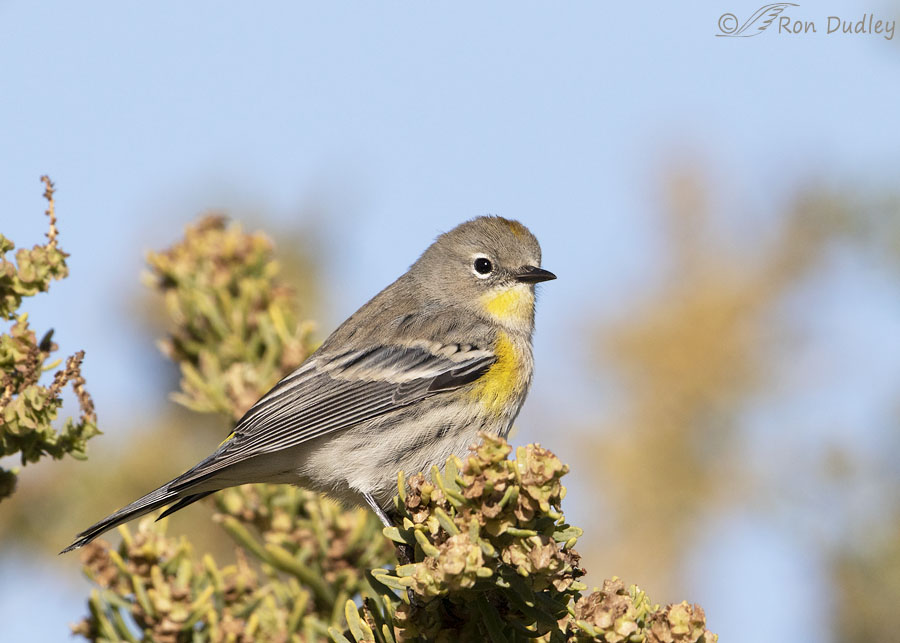
This greasewood bush was buzzing with activity from warblers, sparrows and finches but typical of warblers the yellow-rumped were less prone to come out into the open where they could be photographed well. This one was an exception. It posed nicely for a few moments and then…
turned 180° on the same perch. Here the warbler has spotted an incoming bird that I never did see and this was its reaction. The incoming bird was obviously about to fly overhead so I fired a short burst just to see what I might capture.
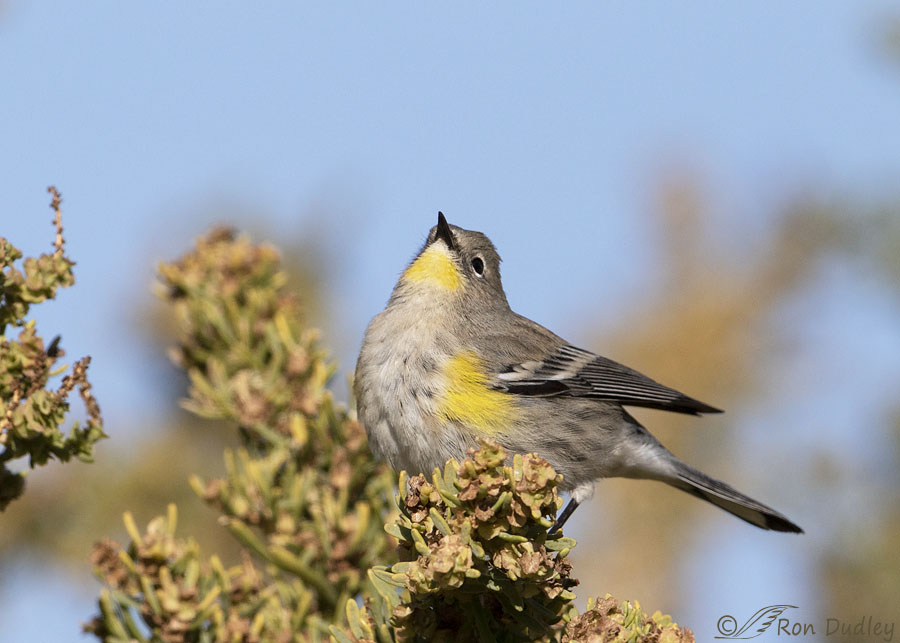
The warbler didn’t take its eyes off the intruder as it passed overhead and this one…
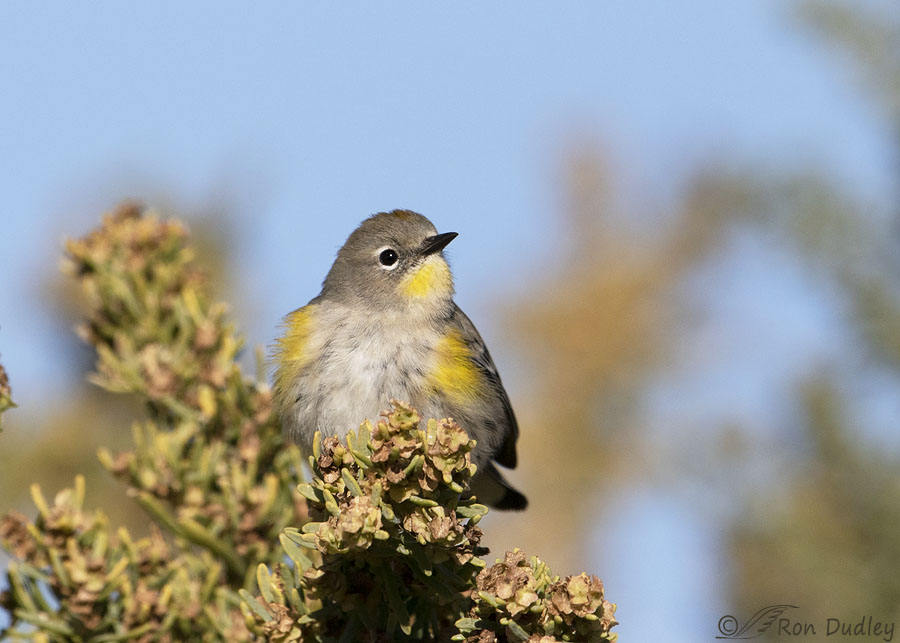
turned to watch it until it had passed by and was no longer of interest. Birds sure don’t miss much.
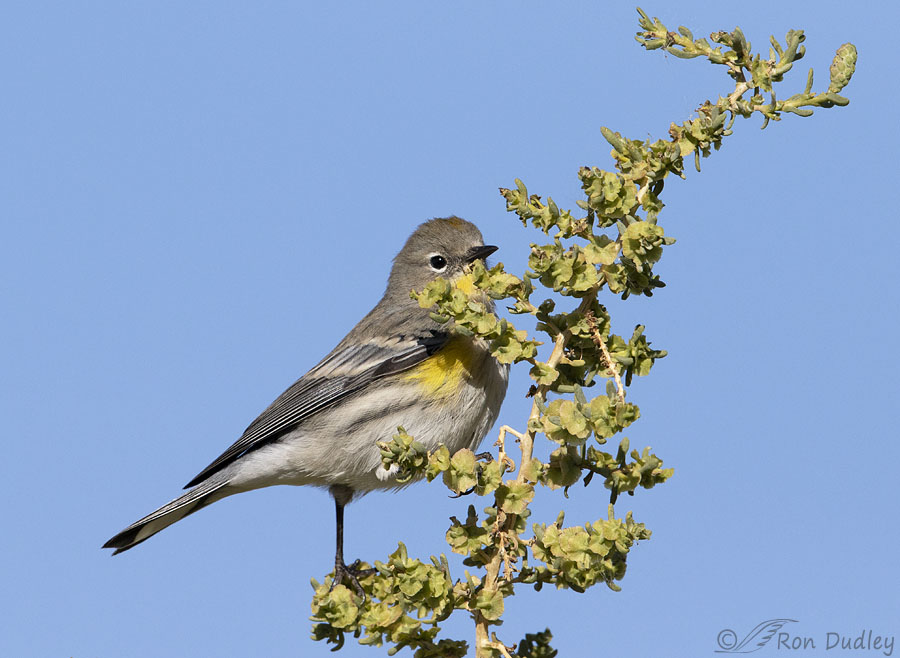
Most of the warblers stayed inside the compact mass of the greasewood or very close to it but this more adventuresome bird perched on one of the few branches that extended vertically a good distance from the bush. Normally I wouldn’t be happy with this much vegetation in front of my subject but I like the composition of the photo with the branch extending to one corner of the frame and the bird peeking out at us over the leaves.
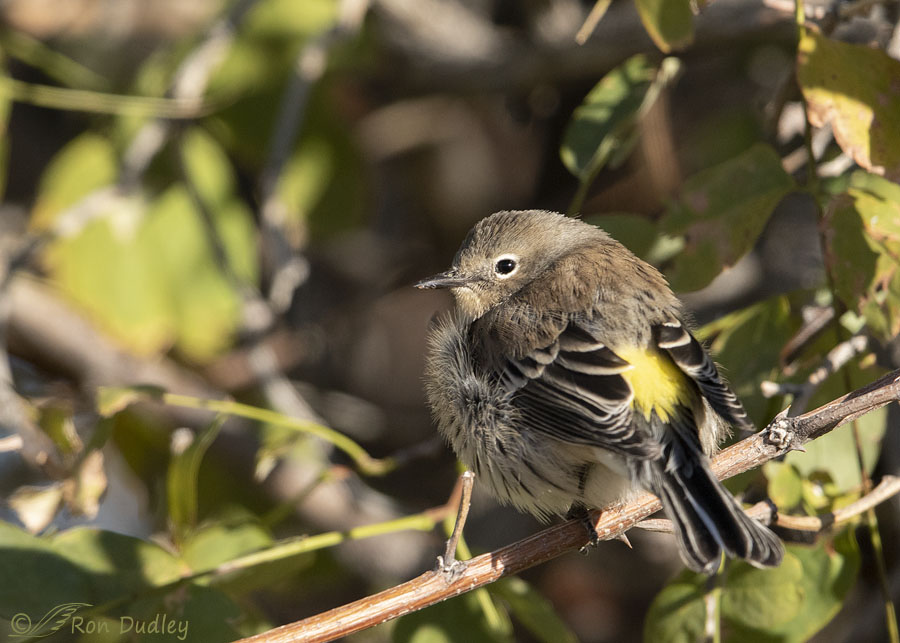
A little earlier that morning it had been very cold, about 20°, so whenever one of the warblers wanted to rest it would move deeper into the vegetation where I usually couldn’t get a clear shot and fluff up to a puffball shape to keep warm. This is about as close to a perfectly round profile as normally streamlined songbirds ever get.
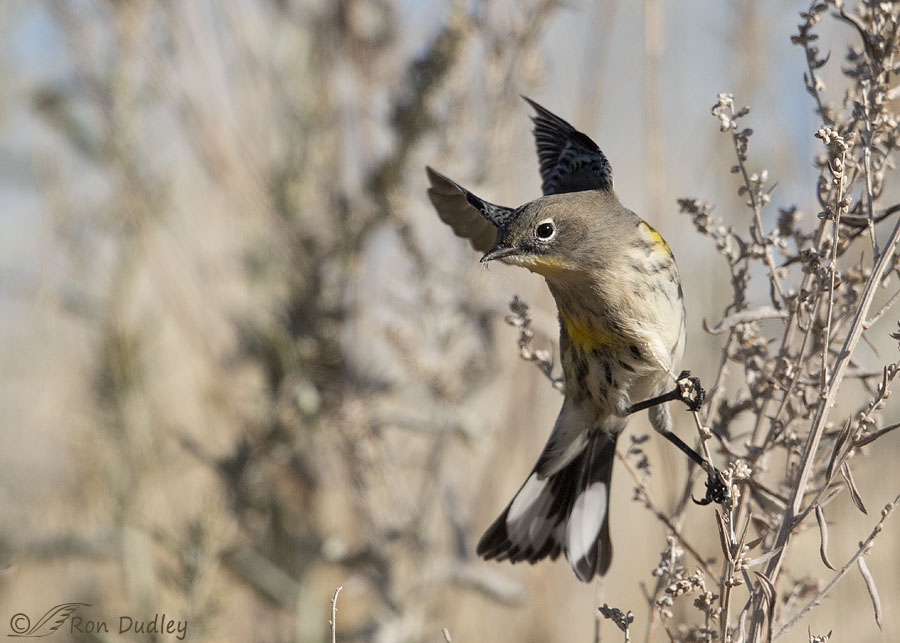
Occasionally, very occasionally, one of the warblers would venture about 6′ to the east to check out some dried vegetation as it looked for insects. They were always strongly side-lit over there but I thought I might get lucky with a takeoff or flight shot as one of the birds returned to the greasewood.
I’m including this series of two photos to demonstrate the tiny difference that often separates a “great shot” from one that deserves to end up in the delete bin. Here the bird was taking off to head back to the greasewood and with this sideways takeoff the next shot in the series had the potential to be pretty spectacular if I could only keep the bird in the frame.
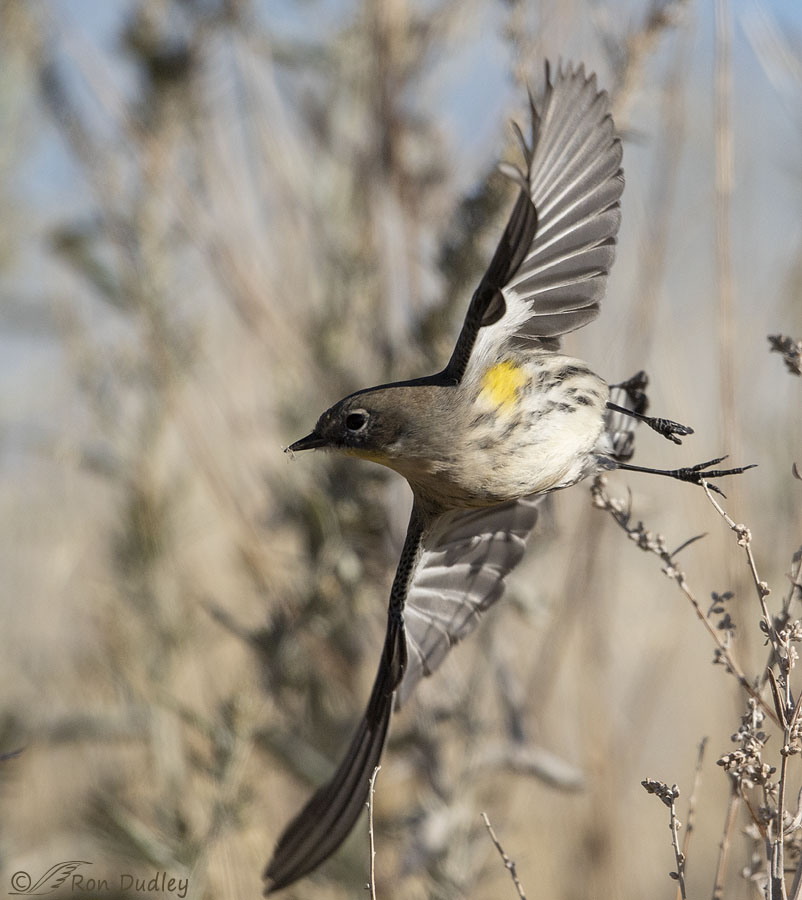
I kept it in frame but just barely.
I adore this vertical flight posture as the bird turned toward the greasewood but the face is too dark and there’s no catch light in the eye. The light made a glancing blow on the face so if the head had been turned only a degree or two my way I’d have had light on the face and probably a catch light. And a photo I’d have liked very much.
In bird photography there’s often only a miniscule difference between a photo that will make the bird photographer ecstatically happy and one that will have him cursing at Murphy once again.
Ron


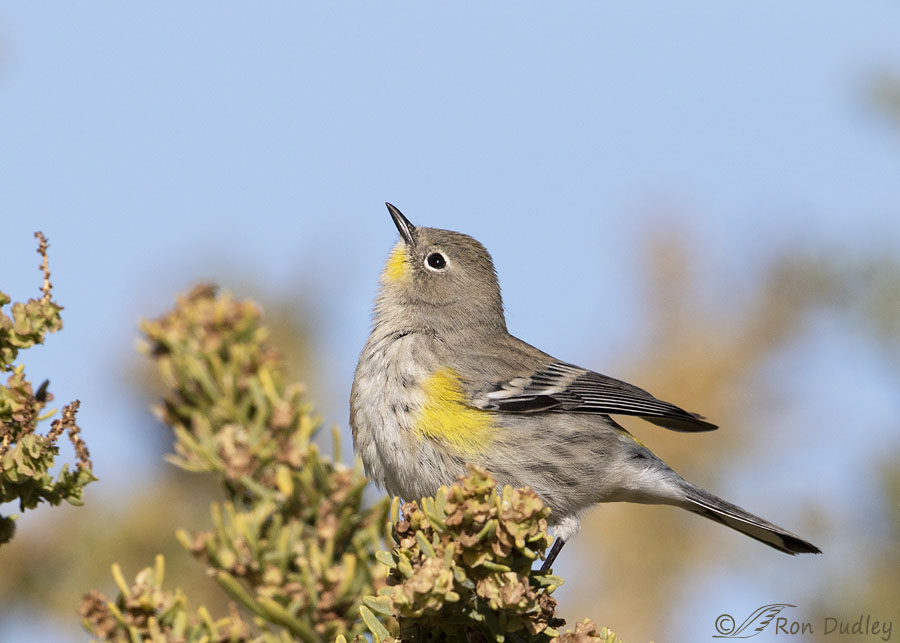
Your Yellow-Rumped Warbler must be looking for the Sharp-shinned Hawk that was prowling my front yard this morning:)
I really like the last take-off shot. You just managed to squeeze that wing tip in.
Yeah, I was counting individual pixels between the wingtip and the frame edge. It only took fingers on one hand…
Ron, it is hard to pick a favorite from these shots, but I’ll try. I like the series where the Warbler is watching something overhead and being cautious. I love the last shot and I’m glad Murphy didn’t do very much damage. The yellow on the Warbler really makes this bird so attractive. Thank you, Ron
Speaking of bird migration on recent posts, I think that the Hummingbirds are doing just that. I haven’t seen them for several weeks.
Thanks, Alice. Our hummers have been gone for a while now.
These shots are so much fun! Shots 2-4 are really interesting to me and 6 is a 2-fer — puffball and great look at that yellow tush! 🙂
I can report that at least one bird species is doing really well here — just saw the green parrot flock on my way in the house. I counted 40 birds before they turned and I lost track. I’m guessing maybe 45-50 birds in that one grouping. I believe there are two or three groups now. They hang out at the university most of the time, but will pop over to the park or into our neighborhood occasionally. 35-odd years ago, there was a pair that hung out in my parents’ coral tree. Not sure if they’re the ancestors of all these, but it is fun to think so. From what I’ve read, they don’t seem to be competing (too much) with native species in most areas. Here’s link to an example article, albeit primarily about birds in the Chicago area. https://www.sciencedaily.com/releases/2019/05/190514162206.h
Marty, it must be both fun and interesting to see those parrots. I don’t know much about them but I’ve heard there have been some concerns…
What a charming series, for which I extend my usual heartfelt thanks. As others have said, birds cannot afford to miss much. Sigh at Murphy, who is more ubiquitous than any of us would like.
Murphy is always nearby, without exception. He sometimes lets things slide but more often he does his dirty deed, especially when it comes to bird photography. Thanks, EC.
Sensational series Ron!
Charlotte
Thanks, Charlotte.
Cool! What a wonderful series! 🙂 I like the first take off shot – just cuz it’s different I guess….. 😉 The peeking out from behind the branch works for me……. Birds don’t miss much – can’t afford to!
I like that first takeoff shot too, Judy – for the reason you mention. And you’re right about the reason they don’t miss much.
Great set of warblers. I have a hard time choosing a favorite…2,3, & 4 are really special…looking up as if to say “keep flying, this post is taken’. I, like Everett, really love the little puffball…just too cute! 😍 Isn’t the migration trigger wonderful…Yellow-Rumped are here in full force right now; still a few kinglets strangling through also.
Kathy, I’ve only seen kinglets on one day lately and there were a bunch of them in the migrant trap where I was shooting. I’m guessing it might be too late to find them there again.
Never mind Murphy — this is a wonderful series.
Thanks, Shoreacres. I like looking at that shot anyway.
I love this set of Audubon’s Yellow-rumped Warbler. Even though some immature females will have a very faint yellow throat, that yellow throat is a dead give-away to Audubon’s subspecies of the Yellow-rumped Warbler. The Myrtle subspecies throat is stark white. No two ways about it. Looking at a female, who will have generally duller plumage anyway, any faint yellow on the throat or close to it will be an Audubon’s.
If I was a young ornithologist wanting to write a book I certainly would be contracting you for many, many images!!
Great post, thanks for sharing.
Sure glad you’re not writing a bird book, Dick! We’ve actually had a few Myrtle’s now and again.
I’m sure you are because I’d be wanting a ton of your images!! VBG!
We can always count on Murphy – that’s for sure. It’s just a matter of where and when. Ron, I love the little ball keeping warm profile. That is my favorite. Excellent series. The first take-off shot is beautiful and the following one would have been too had Murphy not been present. Pretty darn good photo though even with the dark face etc.
Yup, ol’ Murph is as reliable as anyone I know… Thanks, Everett.